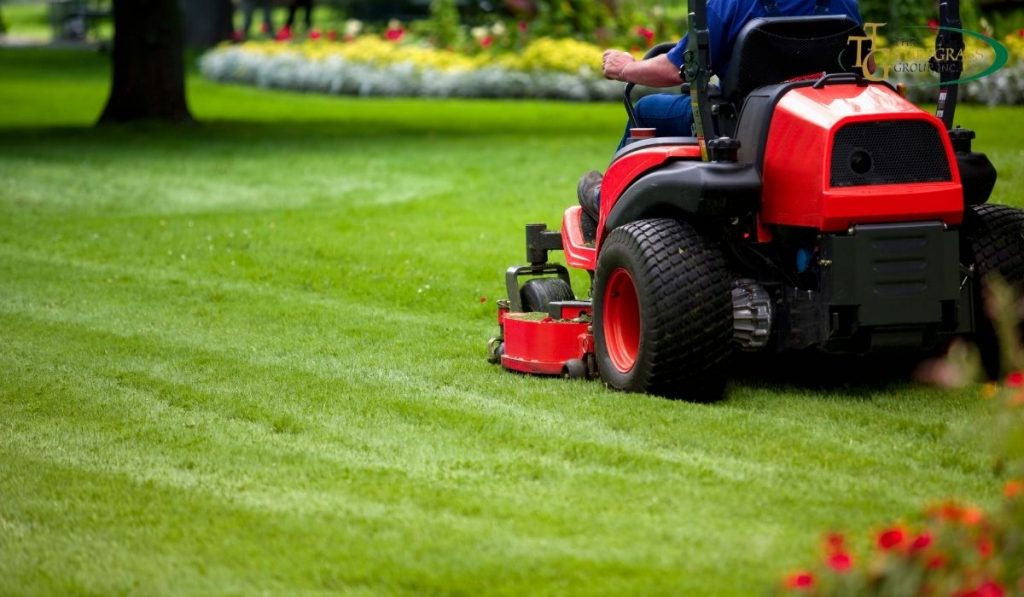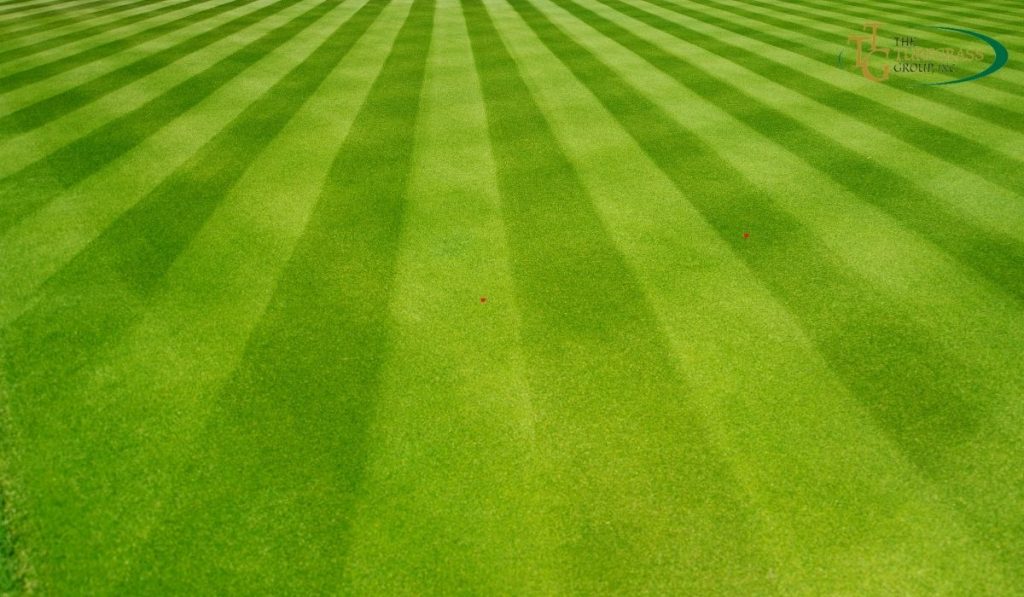
If you live in the South and grow warm-season grass, your grass is in its prime growing season right now.
That means that your grass needs regular mowing to keep its manicured look and avoid cutting too much at once.
But most homeowners would agree that mowing the lawn is not the number one thing they want to do with their spare time.
So if you’re going to keep your grass healthy and looking clean and maintained, you’ll need to find the right balance between how much time you spend mowing and how you want your lawn to look.
More mowing can produce a cleaner look, but if you follow some of these tips, you’ll find the most efficient way to mow your lawn without sacrificing too much time or your lawn’s manicured appearance.
What is the Best Mowing Pattern
One of the most significant factors in how long it takes you to mow your lawn is the pattern you follow.
Some methods are more efficient than others, and your mowing pattern can also affect how your lawn looks.
While mowing a simple rectangle or circle is relatively simple, many residential lawns have odd shapes and obstacles that require a more nuanced mowing plan.
Mowing in Stripes
The most straightforward and most efficient mowing pattern is what most homeowners are already doing.
Mowing in stripes works well for rectangular lawns.
However, even when using this tried-and-true pattern, there are tips that can make you more efficient and yield a better-looking lawn.
First, like Olympic swimmers or baseball players rounding the bases, much of your efficiency comes down to the technique in your turns.
The perfect mower turnaround is tight and doesn’t waste a lot of energy looping around.
Your turns should almost resemble a pivot.
But make sure as you turn that you lift the mower deck to avoid mowing twice damaging your grass.
Mowing stripes can be highly efficient, but only if you keep your lines straight.
A surefire way to lose efficiency is with wiggly lines, which can also leave unmowed patches between imperfect stripes.
A wiggly line from one side of your lawn to the other is significantly longer than a straight line, so with every swerve, you add distance to your mowing regimen.
To get a straight line, start your pattern parallel to a straight line in your landscape, like the edge of a sidewalk or driveway.
As you continue mowing each line parallel to the last, experts recommend keeping a straight line by looking about ten feet ahead of you instead of right in front of the mower.
Some landscapers prefer to mow in the direction that allows for the longest stripes to cut down on turns.
However, experts recommend against mowing in the same pattern every time you mow.
Instead, switch off mowing in vertical and horizontal stripes.
Changing up how you mow will prevent your grass from bending or growing in one direction.
Professional-Looking Stripes
Many homeowners are interested in the clearly discernible stripe patterns you see in many professional sports fields.
The effect is actually not entirely up to how you mow.
Instead, the appearance of darker and lighter stripes is a result of bending the grass in alternate directions.
Grass that bends towards you appears darker, while grass that bends away from you appears lighter.

Professional groundskeepers achieve the look using special striping rollers that bend the grass as they pass over it.
The rollers are typically attached to the mower or pulled behind it.
You can find striping kits for home movers, but they typically cost over $100, and sometimes much more.
Circular Mowing Pattern
After mowing in stripes or rows, the next most efficient way to mow your lawn is in concentric circles.
Depending on the shape of your lawn, this may actually be more efficient.
Concentric circles use the same time-saving technique as mowing in stripes: it’s all about the turns.
Mowing in concentric circles reduces turns and makes the turns wider, so you spend less time maneuvering the mower.
Concentric circles are good for lawns with an irregular shape or lots of obstacles, such as trees or structures.
Mowing in circles gives you more freedom to maneuver around obstacles without significantly altering your mowing pattern.
The Double Spiral
While the double spiral may sound like some sort of exciting figure skating trick, it is actually a very simple and functional mowing pattern.
(Disclaimer: It may also be a figure skating technique. We’re turf experts, not figure skaters.)
The double spiral is very similar to concentric circles, with one distinct advantage: you don’t end up stuck in the center of a freshly-mowed lawn.
While many homeowners may not mind it, for the lawn care connoisseur, walking across a freshly-mowed lawn is a big no-no.
To avoid that, try the double spiral.
Start in one corner of your yard, and follow concentric circles toward the center of your lawn.
As you go, leave a full mower-width between your circles.
When you reach the center, make an S-shaped turn to send you back in the opposite direction.
Mow the unmowed circles in a spiral back out toward the edge of your lawn.
When you’re down, you should end up at the opposite corner of your lawn from where you started, and no need to step on that freshly-manicured emerald carpet.
Features and Edges
The bane of every lawn-mowing hero is those little spots around features and edges.
For a finely manicured look, there is no replacement for a lawn edger.
They aren’t cheap, often running $100 or more, but a good edger is an investment in your lawn just like a good mower.
However, features and edges don’t just pose a challenge for your edger.
Mowing around these tight spots can be a pain and significantly increase the amount of time it takes you to mow your entire lawn.
So when you prepare to mow your lawn, start with these tight spots.
If you have a fence, flower bed, trees, or unusually-shaped edge of your lawn, mow along the border before you mow the rest of your lawn.
When you go back to your regular pattern, you only have to mow up to the area you already took care of.
This puts the difficult work at the front end of your mowing regimen and allows you to follow your general mowing pattern for the most efficient way to mow your lawn.
Why You Shouldn’t Bag Your Clippings
If you are looking for time-saving tips and tricks, experts recommend skipping the time it takes to bag and dispose of your lawn clippings.
For the absolute most manicured look, there is no way to avoid bagging your clippings.
Sports fields and golf courses always remove clippings so that they won’t interfere with gameplay.
But when you’re maintaining your home turf, there are good reasons not to bag your clippings.
Skipping the bagging saves you time. Taking extra time to bag your clippings is simply not the most efficient way to mow your lawn.
It’s really not that much of an eyesore. As long as you are mowing regularly—once a week should be enough—the clippings won’t be thick enough to smother your grass or make unsightly piles.
You should never cut off more than the top third of your grass, so if your clippings are piling up, you should probably be mowing more often.
It’s good for your lawn! All that grass you cut is full of precious nutrients that it absorbed from the soil as it grew.
When you let the clipping naturally decay on your lawn, many of those nutrients are returned to the soil.
Also, a thin layer of clippings can insulate and shade your soil, keeping in moisture and maintaining a steady temperature for your roots.
We just listed three very good reasons not to bag your clippings.
Of course, if you insist on cleaning up your lawn after mowing, there are better and worse ways to dispose of the clippings.
Check out this article we wrote about grass clippings to get all the details.
In short, don’t send clippings to the landfill.
Recycle them as compost, mulch, or even animal feed if you can.
We hope this post helps you find the most efficient way to mow your lawn and shaves some time off your mowing chores.
Remember, even the best mowing plans can’t rescue a low-quality lawn.
For the best-looking, healthiest lawn, always start with high-quality sod from The Turfgrass Group.
You can find a local grower here!
Conclusion
In the realm of lawn care, achieving that perfectly manicured look without spending excessive time mowing can be a challenging feat.
While living in the South during the prime growing season for warm-season grass demands regular mowing, striking a balance between lawn aesthetics and time investment is crucial.
The choice of mowing pattern, such as stripes, circles, or the double spiral, can significantly impact efficiency and appearance.
Additionally, addressing features and edges, while considering the merits of leaving clippings behind, further refines the process.
By adopting these techniques, you can streamline your lawn maintenance routine and enjoy a healthy, pristine lawn without sacrificing your leisure time.
FAQs
What is the best mowing pattern for my lawn?
The best mowing pattern depends on the shape of your lawn. Stripes work well for rectangular lawns, while concentric circles are great for irregular shapes. Experiment with different patterns to find what suits your lawn best.
Is mowing in stripes more efficient than other patterns?

Mowing in stripes is efficient for rectangular lawns, but other patterns like concentric circles or the double spiral can be more suitable for irregular lawns with obstacles.
How can I efficiently make turns while mowing?
To make efficient turns, lift the mower deck slightly, pivot tightly, and avoid looping back. This technique conserves energy and reduces the time spent maneuvering.
What is the significance of straight mowing lines?
Straight mowing lines save time and ensure even coverage. They prevent unnecessary distance due to wiggly lines and help maintain a neat appearance.
Can I achieve professional-looking stripes without special equipment?
While specialized striping rollers can create the professional look, you can achieve similar results by bending the grass in alternate directions while mowing. It might not be as pronounced, but it can still look appealing.
What is the advantage of mowing in concentric circles?
Mowing in concentric circles reduces turns, making maneuvering more efficient. This pattern is particularly useful for lawns with irregular shapes and obstacles.
How does the double spiral mowing pattern work?
The double spiral pattern involves mowing concentric circles toward the center and then spiraling back out. This reduces the likelihood of stepping on freshly-mowed areas while maintaining efficiency.
What’s the best way to approach tight spots and edges?
Start by mowing around features and edges first. This frontloads the challenging work and allows you to follow your general mowing pattern with ease.
Why shouldn’t I bag my lawn clippings?
Not bagging clippings saves time and is beneficial for your lawn. Clippings provide nutrients and act as a natural mulch, retaining moisture and insulating the soil.
Are there any benefits to leaving clippings on the lawn?
Yes, leaving clippings can recycle nutrients back into the soil, improving its health. They also help maintain soil moisture and temperature, promoting a healthier lawn.
Can grass clippings be harmful to the lawn?
Grass clippings are generally not harmful unless they’re left in thick layers that can smother the grass. Regular mowing should prevent this issue.
How often should I mow my lawn to avoid excessive clippings?
Mowing once a week is a good rule of thumb to prevent clippings from becoming excessive. Adjust the frequency based on grass growth rates.
What are some eco-friendly ways to dispose of grass clippings?
Instead of sending clippings to landfills, consider composting them or using them as mulch in your garden. Some people even use them as animal feed for certain animals.
Does high-quality sod impact the efficiency of mowing?
High-quality sod can have a positive impact on mowing efficiency as it grows more uniformly and is easier to maintain.
Where can I find local growers for high-quality turfgrass?
You can search online for local nurseries or garden centers that specialize in turfgrass. They can provide you with high-quality sod options suitable for your region.